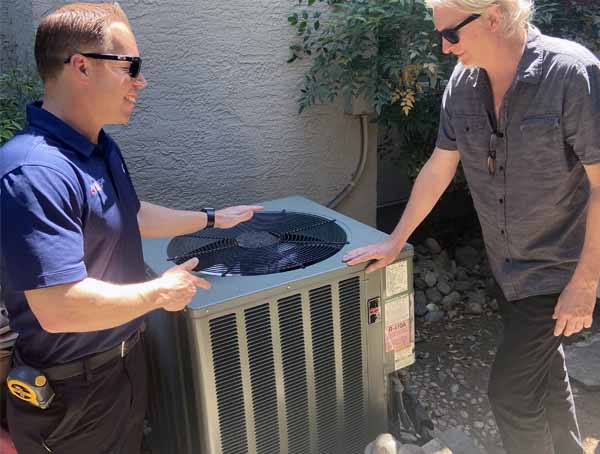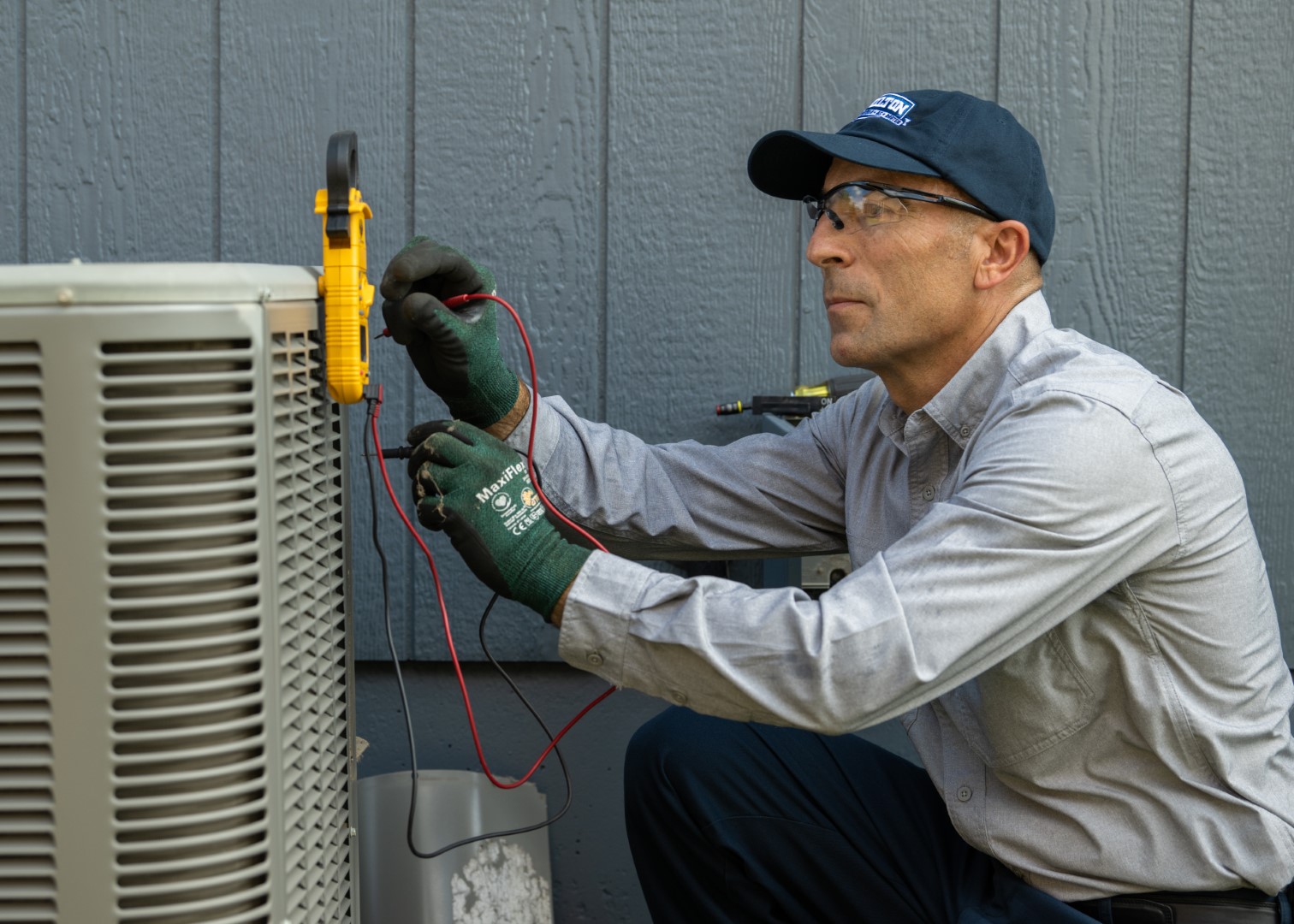All Regarding Heating And Cooling: Identifying Common Issues and Effective Air Conditioning Repair Approaches
Cooling and heating systems are essential for keeping interior comfort. Understanding their components and capability is necessary for recognizing usual issues. Home owners often encounter troubles such as ineffective cooling, odd odors, or climbing energy costs. These indicators can show underlying concerns that may call for interest. Checking out do it yourself troubleshooting techniques can be helpful, yet recognizing when to seek expert assistance is equally important. What actions can be taken to ensure resilient efficiency?
Understanding Your A/c System: Elements and Performance
A HVAC system, typically considered the backbone of indoor climate control, contains several crucial elements that collaborate to regulate temperature and air top quality. The primary elements include the home heating system, air flow system, and cooling unit. The home heating system, usually a furnace or central heating boiler, generates heat throughout colder months, while the cooling system cools interior spaces during the summertime.

Usual Heating And Cooling Troubles Home Owners Encounter
Property owners usually face a number of typical heating and cooling problems, consisting of irregular temperature distribution throughout their space. Furthermore, uncommon noises throughout operation can suggest underlying issues that require attention. Attending to these worries quickly is vital for maintaining optimal system performance.
Irregular Temperature Level Distribution
Several households experience the discouraging issue of inconsistent temperature level distribution, where specific spaces feel annoyingly warm while others continue to be as well cool. This trouble frequently develops from a range of elements, including bad insulation, obstructed vents, or a poorly sized cooling and heating system. When air ducts are not appropriately secured or when furniture obstructs airflow, some areas might receive inadequate cooling. In addition, thermostat positioning can greatly impact temperature policy; a thermostat located in a sunlit location may misrepresent the overall temperature of the home. Regular maintenance, consisting of cleaning filters and guaranteeing ductwork is clear, can help reduce these inconsistencies. Homeowners may likewise think about zoning systems to better control temperature levels throughout different locations of the home, advertising a much more comfortable living setting.
Uncommon Sounds Throughout Operation
When a heating and cooling system runs, uncommon noises can show underlying concerns that call for attention. Home owners might run into a range of sounds, such as grinding, squealing, or hissing. Grinding noises commonly indicate damaged bearings or elements, while squealing can suggest loosened belts or parts requiring lubrication. Hissing might show a refrigerant leakage, which can endanger the system's efficiency. Furthermore, banging audios may indicate loose ductwork or an issue with the blower follower. Each of these noises functions as a caution, triggering house owners to check out even more. Ignoring these indicators can cause even more substantial problems and expensive repair work. Routine maintenance and timely attention to unusual sounds can enhance system durability and performance, guaranteeing a comfy living environment.
Indicators That Indicate Your A/c Needs Repair Service
Just how can one tell if their cooling unit is in demand of fixing? A number of indications may suggest underlying problems calling for specialist attention. Initially, if the air conditioning stops working to cool the area properly, it might recommend a refrigerant leak or compressor breakdown. In addition, an increase in power bills without matching usage modifications could signify inadequacy in the system. Homeowners must also look out to unusual smells emanating from the system, which can show mold development or electrical issues. If the Air conditioner regularly cycles on and off, it may be an indicator of a damaged thermostat or other mechanical troubles. The visibility of water pooling around the device can indicate a clogged drainpipe line. Recognizing these indicators early can conserve time and money, ensuring that the air conditioning system runs efficiently and successfully.
Do It Yourself Troubleshooting Techniques for Cooling And Heating Issues
When encountering HVAC problems, home owners can employ several DIY fixing techniques to determine the trouble. Key methods include inspecting thermostat settings, examining air filters, and evaluating drainage concerns. These actions can help determine typical malfunctions prior to seeking professional aid.
Examining Thermostat Settings
What steps should property owners require to ensure their thermostat settings are appropriate? They must validate the thermostat is set to the desired temperature and setting, whether home heating or air conditioning. Looking for a clear display screen and validating the thermostat is not established to "hold" or "getaway" mode is article crucial. Property owners ought to additionally confirm that the thermostat is degree and installed in an area devoid of drafts, direct sunshine, or various other temperature level influences. Furthermore, altering the thermostat can help give precise readings. If the thermostat operates on batteries, changing them may solve any kind of issues. By methodically evaluating these elements, homeowners can commonly determine and fix thermostat-related problems, advertising ideal cooling and heating system efficiency.
Inspecting Air Filters
Air filters play an important role in keeping ideal cooling and heating performance. They catch dirt, allergens, and various other fragments, making sure clean air circulation. In time, filters can come to be clogged, lowering airflow and efficiency. To check air filters, individuals should initially find the filter, frequently discovered in the return duct or near the heater. Once located, they must assess the filter's condition-- if it appears unclean or blemished, it likely requirements replacement. The majority of filters require transforming every 1-3 months, depending on use and environmental elements. Routine assessment and prompt substitute of air filters not only improve air high quality but likewise extend the lifespan of heating and cooling systems, protecting against prospective malfunctions and costly fixings.
Assessing Drain Issues
Just how can house owners properly determine and resolve drainage concerns within their cooling and heating systems? First, they need to inspect the condensate drainpipe line for obstructions or clogs, which can lead to water accumulation. Property owners may utilize a wet/dry vacuum cleaner to clear any kind of debris obstructing the line. Next off, inspecting the drain pan for rust or leaks is essential, as a harmed frying pan can cause water to overflow. Routine cleansing of the drain line with a mixture of vinegar and water assists prevent future obstructions. In addition, ensuring correct incline of the drainpipe line promotes efficient water flow. If these DIY methods do not resolve the problem, seeking advice from a professional cooling and heating professional might be necessary to prevent prospective water damage and system failing.
When to Call an Expert for Air Conditioner Repair Work

While some air conditioner issues can be handled via do it yourself approaches, there are scenarios where calling an expert comes to be necessary. Homeowners ought to seek experienced assistance when they run into persistent issues, such as inadequate cooling, strange sounds, or uncommon odors rising from the unit. These signs might show much deeper issues that call for specialized understanding and devices to identify and fix appropriately.

Preventative Maintenance Tips for Heating And Cooling Durability
Regular preventative upkeep can greatly boost the durability of HVAC systems. Home owners need to schedule yearly evaluations by certified professionals to assess system performance and determine possible issues. On a regular basis altering or cleaning up air filters is necessary, as this guarantees correct airflow and minimizes pressure on the system. Additionally, checking and sealing ductwork avoids power loss and improves general performance.
It is likewise suggested to keep the outdoor device free from debris and plant life, hvac contractors california permitting peak air flow and heat exchange. Homeowners need to inspect the condensate drainpipe for obstructions to prevent water damage and mold growth. Keeping appropriate thermostat settings and using programmable alternatives can boost power performance. Lastly, recording maintenance activities aids track solution background and can assist in determining recurring concerns (HVAC contractor). By adhering to these preventative procedures, individuals can take full advantage of the efficiency and life-span of their cooling and heating systems
Regularly Asked Questions
Just how Commonly Should I Replace My HVAC System Filters?
HVAC system filters should usually be replaced each to three months, depending on use, filter type, and ecological variables. Regular replacement aids preserve effectiveness and air high quality, guaranteeing peak system performance throughout the year.
What Size Heating And Cooling System Do I Need for My Home?
To identify the ideal HVAC system dimension for a home, one need to consider square footage, insulation top quality, and local environment. Consulting an expert can assist assure maximum efficiency and convenience for the particular living area.
Exist Eco-Friendly Heating And Cooling Options Available?
Yes, green HVAC options are readily available, including energy-efficient warm pumps, solar-powered systems, and geothermal home heating. These options minimize energy consumption and environmental influence, promoting sustainability while maintaining reliable climate control for domestic and business rooms.
Just How Can I Boost My HVAC System's Power Efficiency?
To enhance heating and cooling power efficiency, one can frequently maintain the system, seal air leakages, mount programmable thermostats, use energy-efficient filters, and warranty appropriate insulation throughout the home to decrease energy intake and improve performance.

What Is the Typical Lifespan of a Cooling And Heating System?
The ordinary life-span of an a/c system commonly ranges from 15 to 25 years, depending on variables such as maintenance, use, and the top quality of setup. Regular upkeep can substantially expand its operational durability.
Verdict
In recap, a thorough understanding of HVAC systems encourages property owners to recognize typical issues and address minor problems properly. Identifying indicators of malfunction, employing do it yourself fixing methods, and prioritizing regular upkeep can enhance system efficiency and efficiency. When encountered with intricate repair work, employing specialist help is important to assure safety and security and durability. By cultivating recognition and aggressive treatment, people can enjoy a comfortable interior setting while decreasing unforeseen costs associated with a/c failings.